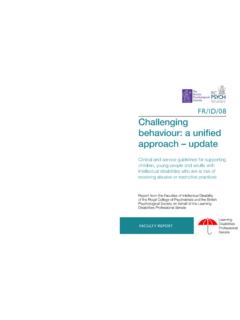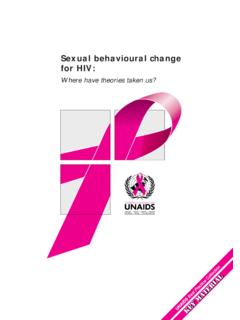Transcription of Pain management: application of cognitive …
1 Pain management: Pain management: application of cognitive application of cognitive behaviouralbehaviouralmethodsmethodsAsso c. Professor Michael NicholasPhDUniversity of Sydney Pain Management &Research CentreRoyal North Shore HospitalStarting point For people with persisting (chronic) pain unless something specific and treatable has been overlooked, curative treatment is very unlikely and its very pursuit may not be The management of persistent pain. Med J Aust 2003; 178(9) Management of chronic low back pain. Med J Aust 2004; 180 (2): 79-83 Loeser JD. Mitigating the dangers of pursuing cure. In: Cohen MJM, Campbell JN, eds. Pain Treatment Centersat a Crossroads: A Practical and Conceptual , IASP Press, 1996 of non-RTW / disability in injured workers: risksrise with: Persisting pain Distress (depression, anxiety, stress) Fears/beliefs (eg. of re-injury , or that can t do things due to pain ) Passive coping (avoidance, escape) History of pain Work issues: satisfaction , conflicts, work availability, transferable skills Demographics: older, female(Abenhaimet al.)
2 , Spine 2000; Bigoset al., AHCPR, 1994; Fordyce IASP, 1995; Linton, IASP, 2002; Pincuset al, Spine, 2002; Waddell & Burton, FOccMed, 2000)As with all interventions Assessment of problem(s) is first step Use history, medical reports, interview, observation, questionnaires Develop working hypothesis about case The intervention is a test of the hypothesis (so, review progress and adjust hypothesis and intervention as needed) Avoid one size fits all approachKey Tasks in CBT for pain patients Reconceptualise pain problems (hurt/harm)(chronic pain model) use Socratic technique Clarify roles, expectations (collaborative vsdirective) Agree on achievable goals (short-term/long-term) Work outsteps towards those goals(eg. prioritizing; pacing) Systematicencouragement for progress towards these goals If necessary, teach skills/coping strategies Identify likely obstacles + plan for solving them Develop maintenance planSocratic Technique A way of eliciting information from patient Yields more specific informationthan if you ask patient for explanations Instead of asking questions that start with why.
3 Use words like when , how , what Eg. Tell me whathappened Or Whatdo you think is happening in your body whenyour pain gets worse? REDUCEDACTIVITYUNHELPFULBELIEFS &THOUGHTSREPEATEDTREATMENTFAILURESLONG-T ERMUSE OF ANALGESIC,SEDATIVE DRUGSLOSS OF JOB, FINANCIALDIFFICULTIES, FAMILYSTRESSCHRONICPAINPHYSICALDETERIORA TION(eg. muscle wasting,joint stiffness)FEELINGS OF DEPRESSION,HELPLESSNESS,IRRITABILITYSIDE EFFECTS(eg. stomach problemslethargy, constipation) M K NicholasEXCESSIVESUFFERINGR econceptualise the problemREDUCEDACTIVITYUNHELPFULBELIEFS &THOUGHTSREPEATEDTREATMENTFAILURESLONG-T ERMUSE OF ANALGESIC,SEDATIVE DRUGSLOSS OF JOB, FINANCIALDIFFICULTIES, FAMILYSTRESSCHRONICPAINPHYSICALDETERIORA TION(eg. muscle wasting,joint stiffness)FEELINGS OF DEPRESSION,HELPLESSNESS,IRRITABILITYSIDE EFFECTS(eg. stomach problemslethargy, constipation) M K Nicholas EXCESSIVESUFFERINGWhat if we roles, expectations Collaborative vsdirective (all stakeholders) Patient must play an active role (not expecting healthcare provider to fix all) Patient must work towards own goals and tasks between sessions at clinic Healthcare provider will provide information, support, guidance (not all the answers) A written manual and charts can helpAgree on Achievable GoalsPutting it simply:Goals = motivationWithout motivation no one is going anywhereGoals vsPain & ImpairmentDouble amputee conquers MountEverest,despite breaking artificial limb on ascentOne of the carbon-fibre legs snapped while climbing at around 6,400 meters, but hewas able to repair it with spare partsWife: He s dreamed of this all his life, probably.
4 He s over the moon Setting goals Specific(eg. walk to shop) Measurable(can see when it s done) Achievable(not unrealistic) Relevant(to the patient = motivation) Timely(within a reasonable time-frame)Specific Goals (examples)Short termIncrease sitting timeIncrease walking timeMop floorStir a pot on stove Long-termReturn to work 8 hrs/dayCook all family mealsSystematicencouragement for progress towards these goals We all respond to feedback Learn faster Strengthen learning HCP smust provide consistent and positive reinforcement for efforts by patients (praise, recognise difficulties) Encourage patient to self-reinforceBut motivation is not enoughWe need a plan: Pacing up an activity despite pain highpacing line (using quotas)ACTIVITY lowTIME (DAYS OR WEEKS)Motivation + a plan may still not be enoughThe skills to carry it out are also requiredProblem-solving is a key skillMain steps: Identify (clarify) problem Identify possible options (solutions) Select best option Try it Evaluate (may need to revise initial perception of problem)Controlling emotional arousal (stress, anxiety) cognitive strategies (eg.)
5 Identify and deal with catastrophic thoughts) behavioural strategies (eg. Relaxation, meditation, desensitization/habituation, Tai Chi, yoga)Dealing with flare-ups in pain Flare-ups should be expected Not a threat, but need to be managed Helps to have a basic plan readyFlare-up plan Recognise pain is worse Check my reactions (thoughts, feelings am I catastrophizing?) Remind myself that I m OK it s just a flare-up, not a new injury (I ve had these before, I expect them and I know they will settle) Calm myself (relaxation, desensitisation/meditation) Check activities (have I been over-doing things?) Plan for day make sure I pace activities, but don t stop everythingIdentify and plan for likely obstacles Patient s usual responses Get upset ( I ve failed again , no point trying ) Fear of failure ( what if it doesn t work? ) Perfectionism ( not good enough , lower standards Family responses/expectations can t be much wrong if no drugs/surgery why don t you try this other Maintenance This is a chronic condition Fluctuations in pain expected Just like diabetes or asthma, need for a long-term management plan Ideally, plan supported by patient s family, doctor, employerIdeal pain self-management skills Maintain most normal activities despite pain, using pacing Recognise functional limits, but gradually extend them Maintain a high level of self-reliance Use alcohol for recreation only (normal social use) Use analgesics sparingly (as an aid, not primary treatment) Deal with increases in pain without becoming distressed Develop and maintain good sleep habits Deal with set-backs, hassles without becoming depressed or despairing Interact with significant others as normally as possible (avoid sick-role)
6 Play an active and informed role in the management of own pain (able to communicate effectively with doctors)Maintenance Plan must include Specific goals (may change over time, but provide direction) Flare-up plan Regular activity pacing Regular monitoring of cognitions/mood/relationships Regular use of calming strategies Regular use of basic exercises (fitness, stretching, Tai Chi) Regular self-reinforcement of efforts (make sure some fun activities included)Conclusion CBT methods can be used by all health professions Assessment is critical Always use a collaborative approach Change is seldom smooth, so patience and consistency are important






